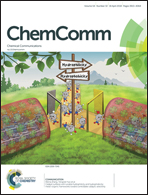A phage display-based strategy for the de novo creation of disulfide-constrained and isomer-free bicyclic peptide affinity reagents†
Abstract
Bicyclic peptides have been attractive scaffolds for developing high affinity reagents for biomacromolecules. Here we report a general phage-screening strategy for the development of bicyclic peptide ligands constrained with isomerically-forbidden disulfide bridges without elaborate chemical modifications and recourses to genetic code reprogramming.



 Please wait while we load your content...
Please wait while we load your content...